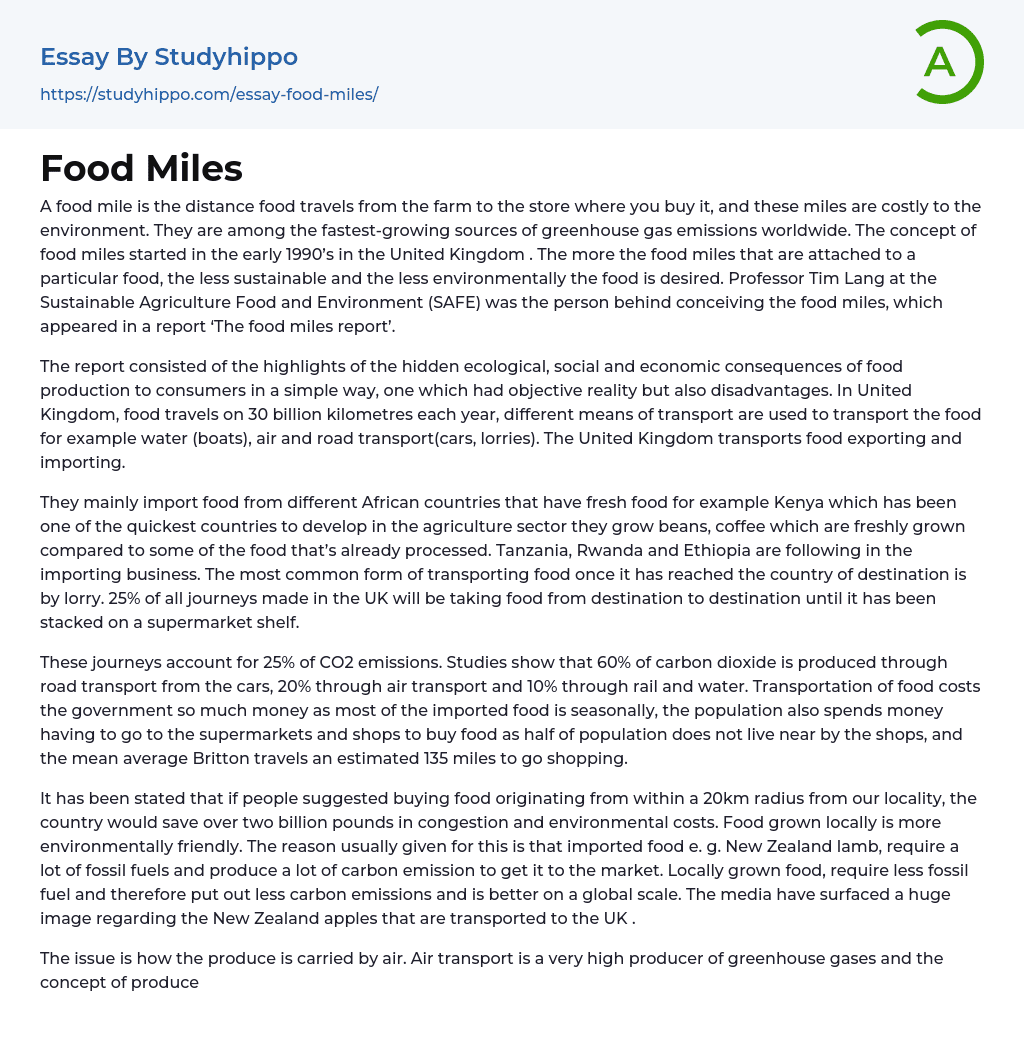A food mile is the distance food travels from the farm to the store where you buy it, and these miles are costly to the environment. They are among the fastest-growing sources of greenhouse gas emissions worldwide. The concept of food miles started in the early 1990’s in the United Kingdom . The more the food miles that are attached to a particular food, the less sustainable and the less environmentally the food is desired. Professor Tim Lang at the Sustainable Agriculture Food and Environment (SAFE) was the person behind conceiving the food miles, which appeared in a report ‘The food miles report’.
The report consisted of the highlights of the hidden ecological, social and economic consequences of food production to consumers in a simple way, one which had objective reality but also disadvantages. In
...United Kingdom, food travels on 30 billion kilometres each year, different means of transport are used to transport the food for example water (boats), air and road transport(cars, lorries). The United Kingdom transports food exporting and importing.
They mainly import food from different African countries that have fresh food for example Kenya which has been one of the quickest countries to develop in the agriculture sector they grow beans, coffee which are freshly grown compared to some of the food that’s already processed. Tanzania, Rwanda and Ethiopia are following in the importing business. The most common form of transporting food once it has reached the country of destination is by lorry. 25% of all journeys made in the UK will be taking food from destination to destination until it has been stacked on a supermarket shelf.
<
style="text-align: justify">These journeys account for 25% of CO2 emissions. Studies show that 60% of carbon dioxide is produced through road transport from the cars, 20% through air transport and 10% through rail and water. Transportation of food costs the government so much money as most of the imported food is seasonally, the population also spends money having to go to the supermarkets and shops to buy food as half of population does not live near by the shops, and the mean average Britton travels an estimated 135 miles to go shopping.
It has been stated that if people suggested buying food originating from within a 20km radius from our locality, the country would save over two billion pounds in congestion and environmental costs. Food grown locally is more environmentally friendly. The reason usually given for this is that imported food e. g. New Zealand lamb, require a lot of fossil fuels and produce a lot of carbon emission to get it to the market. Locally grown food, require less fossil fuel and therefore put out less carbon emissions and is better on a global scale. The media have surfaced a huge image regarding the New Zealand apples that are transported to the UK .
The issue is how the produce is carried by air. Air transport is a very high producer of greenhouse gases and the concept of produce being flown from one side of the world to the other is repellent to many environmentally aware people. However, products like the New Zealand lamb going to the UK are not transported by air, but are freighted by ship, which uses less fossil fuel
and has less emission per kg of produce. The amount of fossil fuel used to import produce pales beside the amount of fossil fuel consumed taking the produce from the point of entry into the country to the depot, to the supermarket and then to the consumer’s home.
In conclusion food miles does not take into account the wider economic benefits that trade provides to consumers. For instance, it is difficult to pin point to whether how changes in preferences by Australian food consumers would affect regional development. A stronger consumer preference towards food products with lower food miles is also potentially harmful to Australian food exporters, as well as those in developing countries.
- Food Safety essays
- Food Security essays
- Beverages essays
- Cuisines essays
- Dairy essays
- Desserts essays
- Fast Food essays
- Bread essays
- Meal essays
- Meat essays
- Organic Food essays
- Rice essays
- Sugar essays
- Taste essays
- Beef essays
- Coconut essays
- Crowd essays
- Dinner essays
- Juice essays
- Sainsbury essays
- Cooking essays
- Ginger essays
- Oreo essays
- Drink essays
- Beer essays
- Wine essays
- Coffee essays
- Tea essays
- Cake essays
- Hamburger essays
- Ice Cream essays
- Burger essays
- Pizza essays
- Fruit essays
- Lemon essays
- Food Waste essays
- Favorite Food essays
- Alcoholic essays
- Soft Drinks essays
- Cookie essays
- Starch essays
- Yeast essays
- Cola essays
- Pizza Hut essays
- snack foods essays
- chips essays
- Biscuit essays
- Brewing essays
- Brewery essays
- Anorexia essays




